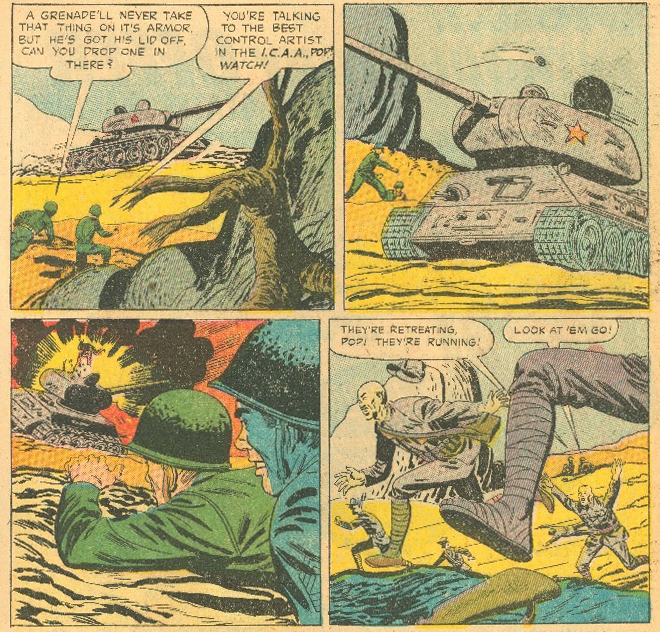The 1952 Marines comic, The Spirit of Semper Fi told the story of a baseball star who received a Selective Service notification just before signing a contract for a professional baseball career. The baseball player, Roger Hart, saw the war as “..a stumbling block between him and big league baseball career,” and approached his service as such.[^] However, after letting down his father, himself a decorated Marine, he changes his viewpoint towards the Marines, and utilizes his athletic abilities to be an exemplary soldier.
Roger’s status as a star pitcher is a central component of the comic, and is used to provide readers an idea of Roger’s background and identity. The cover image shows Roger pitching a in large park, alongside images of Marines in combat.[^] The story picks up as Roger strikes out the final batter in his no-hitter, and he meets with a scout who tells him he has a contract and bonus check with him.[^] Here, Roger’s pitching ability is clearly articulated, and his promise for a big league career is made abundantly clear. He also makes it clear that he doesn’t want to join, and that his father’s thirty year career has not sufficiently rewarded him.
Roger’s disinterest in the military is abundantly clear, and he disappoints his father by failing to put out a box of uniforms that catch fire.[^] His father berates him for disobeying orders and not respecting the Marine uniforms, and even calls out his manhood, exclaiming, “Don’t call me ‘Pop’, you poor excuse for a man! Go play with your bats and balls and leave me alone!”[^] Roger remained skeptical of the “Spirit of Semper Fi,” until a close brush with the enemy. A Communist soldier charged towards his position and came within inches of killing him with his bayonet.[^] Another solider came in at the last moment and intercepted the charging enemy, and Roger finished him with his bayonet.[^] After this, Roger “has the Marine Corps spirit,” as his associate tells him, and when his father asks for a volunteer, he jumps at the opportunity.[^] His father wants someone to provide cover fire while he throws a grenade, but Roger, insisting that he is “still the pitcher,” volunteers to throw the grenade.[^] Roger is able to throw a grenade into the open lid of a passing tank, a nearly impossible task, and the resulting explosion sends the much larger force retreating in fear.[^] Roger’s elite athletic skills and his newfound feeling of Semper Fi, come together to make him a war hero and an exemplary man. Roger and his father engage in a canteen toast to ”…the best pitcher west of the Polo Grounds!,” “…the best old man a guy ever had…” and “…to the Marine Corps and the Spirit of Semper Fi!”[^]
In contrast to the nearly all of the recruiting pieces, which tout the job opportunities that come from service,this piece shows a young man who sees military service as an interruption to a promising career. This is likely due to the difference in circulation, as the Marines publications were directed towards those who were already enlisted. This piece sought to instill pride and honor in the “Spirit of Semper Fi” - to encourage men to align behind the principles and spirit of the Marine Corps. The choice of a star athlete as the main character is interesting here - the character could have been in any number of professions, or had any number of promising opportunities, but the authors chose to represent this Semper Fi awakening with a star athlete. By doing so, they take a man who is well respected and has proven himself through physical superiority and a strong work ethic.
Even though the professional athlete was skeptical of the Marine way, and had very good social and economic opportunities outside of the Marines, he was still able to see the draw of “The Spirit of Semper Fi,” and bought into the service. Furthermore, a clear connection is made between the kind of skills and composure needed in sports with the same kinds of values required of servicemen.
Related Sections
- Be a Big Wheel
- Be a Big Wheel - Athletic & Physical Prowess
- Be a Big Wheel - Athletic & Physical Prowess - It's All in the Family!
- Be a Big Wheel - Athletic & Physical Prowess - At the Ramparts
- Be a Big Wheel - Athletic & Physical Prowess - Dick Wingate in the US Navy
- Be a Big Wheel - Athletic & Physical Prowess - Five Years Later..>Where Will You Be?
- Be a Big Wheel - Athletic & Physical Prowess - Look After My Billy!
- Be a Big Wheel - Athletic & Physical Prowess - Mister Marine Corps
- Be a Big Wheel - Athletic & Physical Prowess - US Air Force Academy
Primary Sources
Secondary Sources




